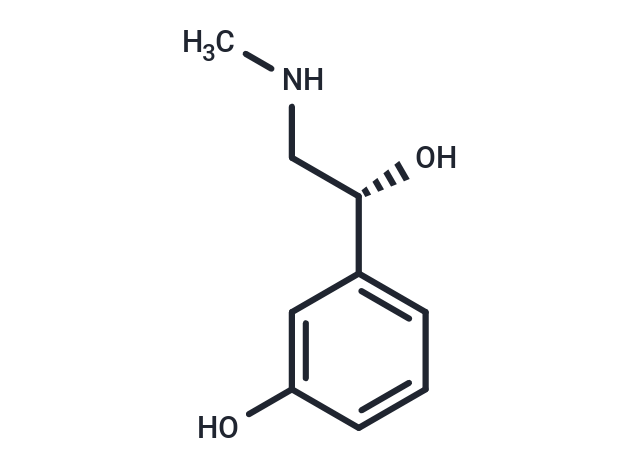Shopping Cart
Remove All Your shopping cart is currently empty
Your shopping cart is currently empty
Phenylephrine ((R)-(-)-Phenylephrine) is a selective α1-adrenoceptor agonist ( pKi: 5.86, 4.87 and 4.70 for α1D, α1B, and α1A receptors respectively).

| Pack Size | Price | USA Warehouse | Global Warehouse | Quantity |
|---|---|---|---|---|
| 500 mg | $42 | Inquiry | Inquiry | |
| 1 mL x 10 mM (in DMSO) | $45 | In Stock | In Stock |
| Description | Phenylephrine ((R)-(-)-Phenylephrine) is a selective α1-adrenoceptor agonist ( pKi: 5.86, 4.87 and 4.70 for α1D, α1B, and α1A receptors respectively). |
| Targets&IC50 | α1B-adrenoceptor:4.87 (pKi), α1A-adrenoceptor:4.70 (pKi), α1D-adrenoceptor:5.86 (pKi) |
| In vitro | Phenylephrine promotes cardiac fibroblast proliferation. Phenylephrine activates CaN and evokes NFAT3 nuclear translocation. It suggests that the Ca(2+)/CaN/NFAT pathway mediates Phenylephrine-induced cardiac fibroblast proliferation, and this pathway might be a possible therapeutic target in cardiac fibrosis [1][2][3]. |
| In vivo | Phenylephrine could enhance the alveolar fluid clearance in high tidal volume-ventilated rats and accelerate the absorption of pulmonary edema. Perfusion of hearts with Phenylephrine (100 μM) induces a rapid (maximal at 10 min) 12-fold activation of two p38-MAPK isoforms. α1-adrenoceptor agonists such as Phenylephrine increase the contractility of the heart. Phenylephrine also activates SAPKs/JNKs in neonatal ventricular myocytes [4][5]. |
| Synonyms | L-Phenylephrine, (R)-(-)-Phenylephrine |
| Molecular Weight | 167.21 |
| Formula | C9H13NO2 |
| Cas No. | 59-42-7 |
| Smiles | CNC[C@H](O)c1cccc(O)c1 |
| Relative Density. | 1.1222 g/cm3 (Estimated) |
| Color | White |
| Appearance | Solid |
| Storage | Powder: -20°C for 3 years | In solvent: -80°C for 1 year | Shipping with blue ice/Shipping at ambient temperature. | ||||||||||||||||||||||||||||||||||||||||
| Solubility Information | DMSO: 100 mg/mL (598.05 mM), Sonication is recommended. H2O: 5 mg/mL (29.9 mM), Sonication is recommended. | ||||||||||||||||||||||||||||||||||||||||
| In Vivo Formulation | 10% DMSO+40% PEG300+5% Tween 80+45% Saline: 5 mg/mL (29.9 mM), Sonication is recommended. Please add the solvents sequentially, clarifying the solution as much as possible before adding the next one. Dissolve by heating and/or sonication if necessary. Working solution is recommended to be prepared and used immediately. The formulation provided above is for reference purposes only. In vivo formulations may vary and should be modified based on specific experimental conditions. | ||||||||||||||||||||||||||||||||||||||||
Solution Preparation Table | |||||||||||||||||||||||||||||||||||||||||
H2O/DMSO
DMSO
| |||||||||||||||||||||||||||||||||||||||||
| Size | Quantity | Unit Price | Amount | Operation |
|---|

Copyright © 2015-2026 TargetMol Chemicals Inc. All Rights Reserved.